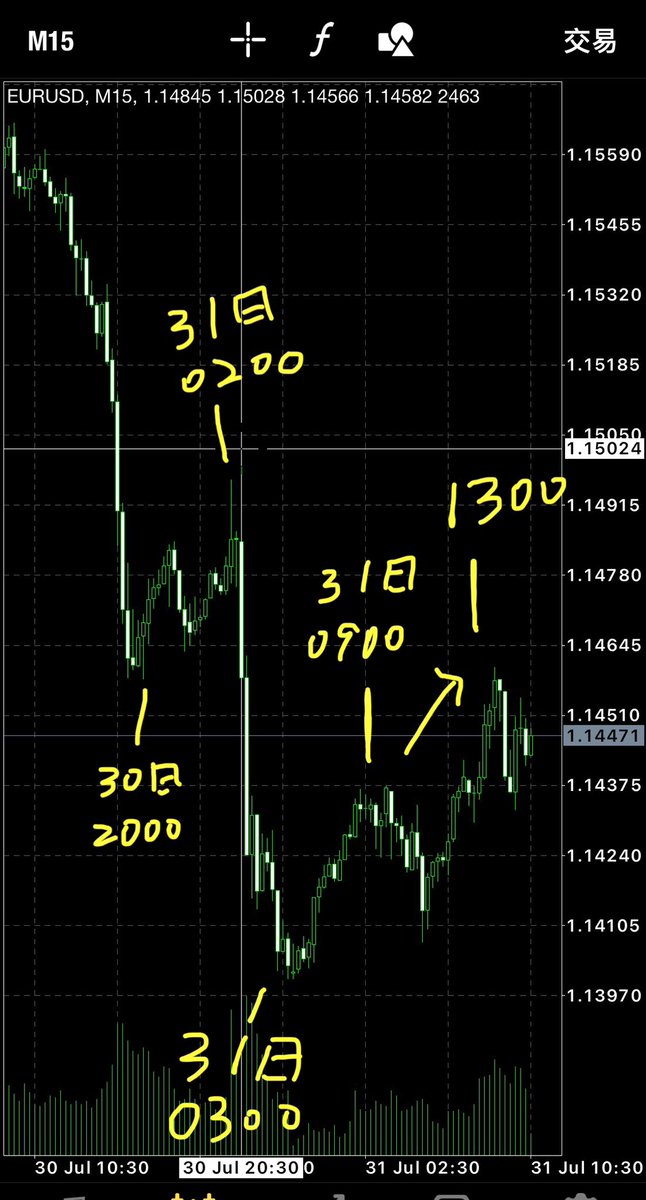Since the launch of the Pi wallet, which allows direct purchases of Pi within the wallet, the subsequent trends in relation to foreign exchange conditions are as follows based on the logic mentioned earlier:
The attached chart shows the trends of EUR/USD and PI/USDT.
As mentioned earlier, since the wallet provides fiat liquidity, a decline is observed in the non-USD foreign exchange series, while an increase is related to Pi supply.
Thus, we can see a correlation in this downward trend.
Before 8 PM on the 30th, both reached their low points at the same time.
The timing of the high point at 2 AM and the low point at 3 AM on the 31st is also the same.
Subsequently, as we approach 9 AM on the 31st, the increase in Pi is related to the sum of foreign exchange and Pi buy orders, which is why Pi experienced a rise greater than EUR. This completely aligns with the speculative logic.
Why is it different after 9 AM on the 31st?
Because the increase is due to foreign exchange plus Pi, and since there are more buy orders for Pi, after the buy orders end, it will automatically balance the price based on the liquidity constant formula, thus the comparison from 3 PM to 1 PM is the same.
Conclusion: According to the logic from the previous article, it is very consistent that the decline is related to foreign exchange, while the increase is related to Pi supply, which is foreign exchange plus Pi buy orders.
It should be understood that this means whenever there is positive news about Pi, the trend will be very vigorous.
Some may raise a question: If the upward trend is vigorous, can the downward trend also be vigorous?
To clarify, the downward vigor is when Pi investors sell on the exchange, which reflects the exchange price. As explained in the previous article, the on-chain price is completely independent of the exchange; the exchange price is a private trading market, akin to the price of an in-game item, unrelated to on-chain currency or fiat.
A decline in exchange price will not affect the on-chain price, as there is no sell button on-chain; it is entirely based on a large foreign exchange reserve for liquidity.
#PI
#pi


To the vast number of pi users, I have a question for everyone:
What do you think about the following views?
1. The pi wallet can only purchase pi using fiat currency through card payments, while banza can be said to merely assist in selling pi and help investors from a hundred countries use their local fiat currencies to exchange for pi.
2. Therefore, when investors receive the pi sold on consignment,
banza receives fiat currency from a hundred countries, assists in converting it to USD, and then returns the USD to the suppliers providing pi.
3. Thus, it can be understood that the pi wallet generates its own on-chain price based on independent on-chain liquidity, which is unrelated to exchange prices.
4. Therefore, the pi wallet only has the function to purchase from an independent on-chain liquidity pool, which consists solely of fiat/pi. There is only a purchasing function, with no selling function. Hence, it can be inferred that the price fluctuations of pi come from foreign exchange. For example, pi/USD, pi/EUR, pi/RMB, pi/JPY, pi/AUD.
It is known that all foreign exchange is based on USD as the settlement benchmark, so it can be understood that since the wallet only has a purchasing function, the only way to cause a decline in the on-chain price of pi is through fluctuations in a basket of foreign exchange. However, the fluctuations in foreign exchange are very small, so any decline will also be very small.
On the other hand, the liquidity suppliers for pi seem to come from exchange supplies, but the exchange only supplies pi, which is unrelated to the price of pi within the exchange. Therefore, there will be two prices generated here: one is the on-chain price, and the other is the price of pi on the centralized exchange itself.
5. From the above, it can be understood that when all the on-chain pi is bought out and liquidity decreases, the constant liquidity multiplication formula will automatically balance the dual currency prices, resulting in an increase in the on-chain pi price.
*Here comes the question: How do you view the situation where the on-chain pi price and the exchange price may differ significantly?
Because the exchange price can be manipulated, but the on-chain pi price is based on a basket of fiat currencies, and there is no function to sell pi for fiat on-chain. There is also no pi/usdt pool on-chain. Therefore, the on-chain pi price is unlikely to drop significantly.
Have you ever thought about the scenario where the on-chain pi price is 0.45, while the exchange price is manipulated to 0.1?
What are your thoughts on this?
100.54K
9
The content on this page is provided by third parties. Unless otherwise stated, OKX is not the author of the cited article(s) and does not claim any copyright in the materials. The content is provided for informational purposes only and does not represent the views of OKX. It is not intended to be an endorsement of any kind and should not be considered investment advice or a solicitation to buy or sell digital assets. To the extent generative AI is utilized to provide summaries or other information, such AI generated content may be inaccurate or inconsistent. Please read the linked article for more details and information. OKX is not responsible for content hosted on third party sites. Digital asset holdings, including stablecoins and NFTs, involve a high degree of risk and can fluctuate greatly. You should carefully consider whether trading or holding digital assets is suitable for you in light of your financial condition.

